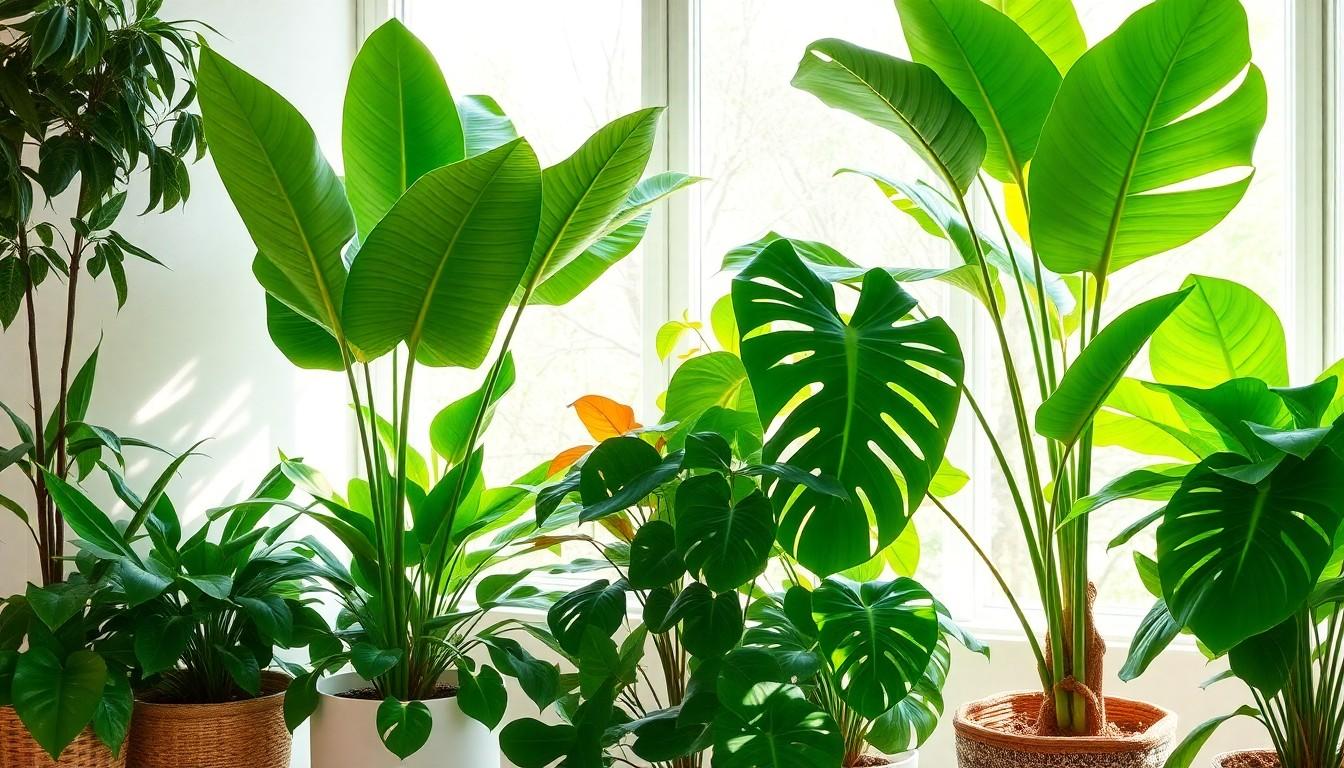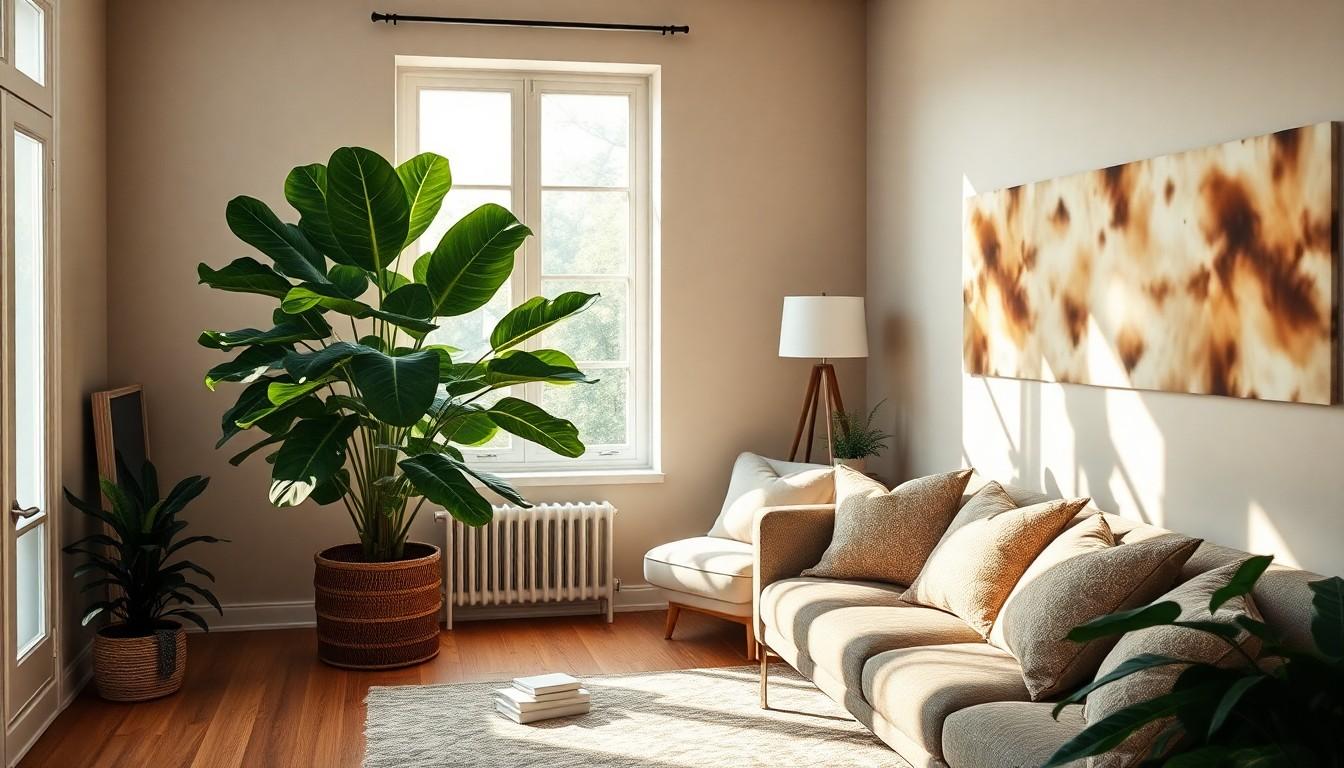Indoor large house plants are the unsung heroes of home decor. They don’t just sit there looking pretty; they bring life to a space, improve air quality, and even boost mood. Imagine walking into a room filled with lush greenery, where your stress melts away faster than ice cream on a hot day. Who needs a therapist when you’ve got a towering fiddle leaf fig?
Overview Of Indoor Large House Plants
Indoor large house plants offer significant aesthetic and health benefits. These plants contribute to improved air quality by absorbing toxins and releasing oxygen. Additional advantages include stress reduction, as their presence can create a calming atmosphere.
Many varieties thrive indoors, such as the Fiddle Leaf Fig and the Rubber Plant. Fiddle Leaf Figs feature broad leaves, making them striking focal points in living areas. Rubber Plants are known for their glossy leaves, providing a touch of sophistication.
Selecting the right plants depends on space and light conditions. Plants like the Monstera Deliciosa adapt well to various light environments, showcasing impressive foliage. Alternatively, the Bird of Paradise offers vibrant blooms, adding color to any room.
Indoor large house plants require varying levels of care. Some, like the Snake Plant, are low-maintenance, thriving on neglect. Others, such as the Peace Lily, need regular watering to maintain their lush appearance.
Placement plays a crucial role in maximizing their impact. Positioning plants near windows ensures they receive adequate sunlight. Grouping plants can enhance visual appeal, while taller species can anchor corners of rooms.
Incorporating large house plants transforms spaces. They serve not only as decorative elements but as vital contributors to well-being. Embracing these green companions enriches homes with warmth and life.
Benefits Of Indoor Large House Plants

Indoor large house plants offer significant advantages for home environments. They bring life to spaces while contributing positively to health and well-being.
Improved Air Quality
Large house plants excel at purifying the air. They absorb harmful toxins such as formaldehyde and benzene, effectively reducing indoor pollution. NASA’s Clean Air Study highlights the ability of specific plants to filter air, further enhancing their value as indoor companions. By incorporating a variety of plants, individuals can create a healthier living atmosphere. Species like the Rubber Plant and Peace Lily stand out for their air-cleaning capabilities. Increased oxygen levels from these plants promote better respiratory health.
Aesthetic Appeal
Large indoor plants significantly enhance the visual allure of any room. Their presence adds color, texture, and life to spaces, transforming ordinary areas into lush environments. Fiddle Leaf Figs and Monstera Deliciosa are particularly sought after for their striking foliage. Designers often recommend grouping these plants to create focal points and depth. Integrating greenery into interior design fosters an inviting atmosphere, making homes feel more vibrant. The size of these plants allows for bold statements, elevating overall decor.
Stress Reduction
The calming effect of indoor large house plants contributes to stress reduction. Interaction with nature lowers cortisol levels, promoting relaxation and well-being. Studies show that merely being around plants can elevate mood and increase feelings of tranquility. Engaging with greenery inspires mindfulness and enhances focus. Snake Plants and Peace Lilies serve as excellent choices for those seeking stress relief. Regularly caring for plants can also provide a sense of accomplishment and purpose, improving mental health.
Types Of Popular Indoor Large House Plants
Indoor large house plants elevate decor while bringing numerous benefits. Several popular varieties thrive in home environments, each with unique characteristics.
Fiddle Leaf Fig
Fiddle Leaf Fig stands out with its broad, glossy leaves that create a striking focal point. This plant prefers bright, indirect sunlight but can adapt to lower light conditions with care. It grows tall, often reaching heights of six feet, making it ideal for spacious rooms. Regular watering and humidity are crucial to maintaining its vibrancy, as dry air can lead to leaf drop. Placing it near a window enhances growth and showcases its beauty effectively.
Monstera Deliciosa
Monstera Deliciosa, also known as the Swiss Cheese Plant, features large, dramatic leaves with distinctive splits. This plant thrives in bright, indirect light and tolerates lower light if needed. Growth can extend to ten feet or more, contributing to its presence in any space. Watering when the top inch of soil dries keeps the plant healthy. Its ability to purify air enhances indoor quality while adding a tropical feel to interiors.
Rubber Plant
Rubber Plant exhibits glossy leaves that vary in color, providing versatility in design. Known for its robust nature, it can thrive in various lighting conditions, from bright, indirect to low light. This plant typically grows up to eight feet tall, making it suitable for both small and large spaces. Consistent watering promotes healthy growth while avoiding over-watering prevents root rot. Emphasizing its aesthetic appeal, the Rubber Plant enriches homes with deep green hues, blending seamlessly into diverse decor styles.
Care Tips For Indoor Large House Plants
Caring for indoor large house plants involves understanding their specific needs. Proper light, water, and nutrients enhance growth and vitality.
Light Requirements
Bright, indirect sunlight significantly benefits large house plants. Fiddle Leaf Figs thrive in such conditions, making them ideal for sunny corners. Monstera Deliciosa, with its dramatic leaves, adapts well to moderate light but flourishes in bright spots. A consistent light schedule promotes strong growth, preventing leggy stems. Shaded areas generally hinder these plants’ growth potential. Rotate plants every few weeks to ensure even light exposure.
Watering Needs
Watering needs vary among different large house plants. The Snake Plant tolerates dry soil, while Peace Lilies require more frequent watering. Ensuring the top inch of soil dries out between waterings prevents overwatering. Allowing water to drain from pots prevents root rot, a common issue in indoor plants. Monitoring humidity levels contributes to healthier plants, especially during winter months. Their growth may slow during dormant periods, necessitating adjustments in watering frequency.
Fertilization Strategies
Balanced fertilizers support robust growth in large house plants. Using a 20-20-20 formula every 4-6 weeks during the growing season enhances nutrient availability. Diluting fertilizers to half strength prevents nutrient burn and promotes steady growth. Regular fertilization during the spring and summer encourages lush foliage. Observing plant responses helps adjust fertilization schedules. Soil testing every six months can also provide valuable insights into nutrient needs.
Common Pests And Problems
Indoor large house plants can encounter various pests and issues. Identifying these problems promptly ensures healthier plants.
Identifying Pests
Some common pests affecting indoor plants include spider mites, aphids, and mealybugs. Spider mites often create fine webs on plant leaves, indicating their presence. Aphids cluster on new growth or undersides of leaves, sucking sap from the plant. Mealybugs appear as fuzzy white clusters, usually found in leaf axils. Regular inspection plays a crucial role in early detection. Observing leaves for discoloration or sticky residue can help spot infestations quickly.
Solutions And Preventative Measures
Implementing preventative measures contributes to maintaining plant health. Regularly cleaning leaves with a damp cloth removes dust and pests. Insecticidal soap serves as an effective treatment for minor infestations. Encouraging natural predators, like ladybugs, can help control pests. Quarantining newly acquired plants prevents the spread of problems to existing ones. Maintaining optimal humidity and air circulation wards off many issues. Monitoring soil moisture also promotes overall plant vitality.
Conclusion
Indoor large house plants are more than just decorative elements; they’re vital contributors to a healthier living environment. By choosing the right varieties and providing proper care, anyone can enjoy the numerous benefits these plants offer. From enhancing air quality to elevating mood, their presence transforms spaces into serene retreats.
With options like the Fiddle Leaf Fig and Monstera Deliciosa, there’s a perfect plant for every home. Proper placement and care ensure these plants thrive, bringing life and warmth to any room. Embracing large house plants not only beautifies a space but also nurtures well-being, making them an essential addition to modern living.

